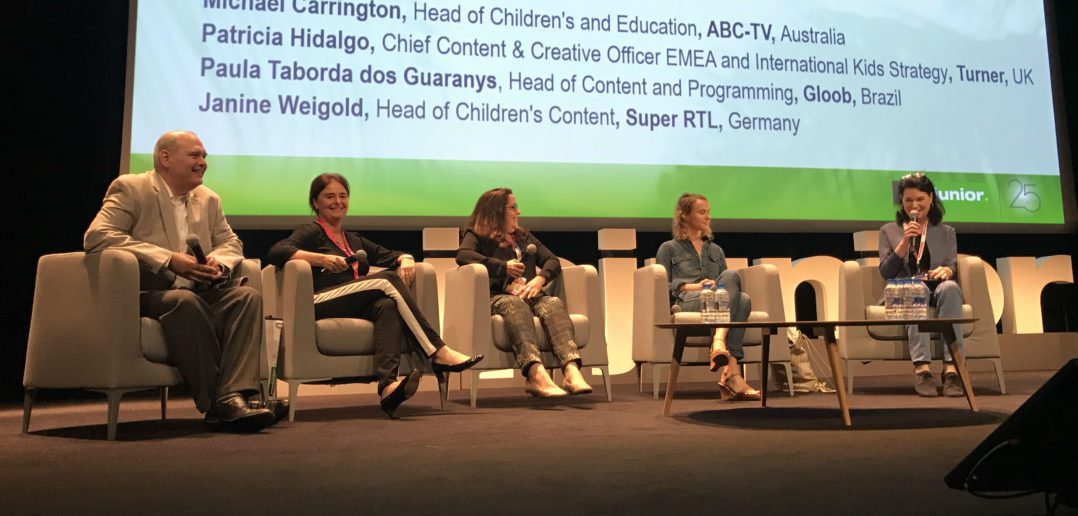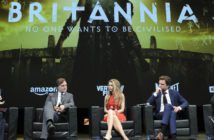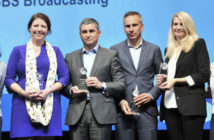This year’s trends in children’s entertainment were under the microscope as MIPJunior’s 25th anniversary edition got underway today, including a panel where four programming experts gave their perspectives on the defining content of 2017.
The panel included Michael Carrington, head of children’s and education at ABC-TV in Australia; Patricia Hidalgo, chief content and creative officer EMEA and international kids strategy at Turner; Paula Taborda dos Guaranys, head of content and programming at Gloob; and Janine Weigold, head of children’s content at Super RTL. The moderator was Anna Cargugati-Guise, group editorial director at World Screen.
Carrington kicked off with his views on public-service broadcasting in 2017. “The role of a public service broadcaster hasn’t really changed. We’ve always wanted to reflect and engage our audience from a local perspective, but then to give them a window on the world,” he said.
Hidalgo talked about the differences in the audience across the world for these shows. “Children are much more similar in different cultures than adults are, and this is even more true the younger they are,” she said.
“But you do see that children are younger for longer in some markets than others, so some content might be appealing to a six year-old in one market or an eight year-old in another. You also find that some content doesn’t travel as well as others: live-action doesn’t travel as well in some markets… The only thing that is really universal about kids’ content is animation. Animation works everywhere.”
Guaranys talked about Gloob’s plans to launch a new pre-school channel this month, while Weigold said that Super RTL has benefited from the loyalty of its audience over the last 25 years, before the conversation turned to diversity.
“Children want to see themselves reflected. They may be disabled children, they may be indigenous children, they may be children from families that have immigrated to the country they are living in. We are very aware and open to telling those stories,” said Carrington. “And also behind the camera. When we are telling a story about the aboriginal peoples in Australia, we would want to make sure we have people behind the camera… telling that story, so that it’s an authentic voice.”
“It’s really important in a world today that’s quite fragmented, and we know about the things we hear around the world with Brexit and Trump and North Korea, that children are hearing that stuff and they feel unsettled. So this is also a way in grounding them in where they are, and making sure they feel grounded and championed.”

Guaranys talked about how Gloob, as part of Globo TV, tries to preserve a Brazilian DNA in its shows, while working with international coproduction partners.
“We have a lot of original productions. We understand that children want to see themselves on TV, so in the way we worked to differentiate ourselves was by producing original content with kids. A lot of live-action shows,” she said. “But the values that we have are values that are universal. We understand that the content that we produce – the situations we’re going to put in the show – will reflect and resonate all over the world.”
Weigold addressed Super RTL’s strategy between its linear channel and its online streaming service Kividoo.
“For the linear channel actually we focus on a target group from three to nine years old. We need to reach the masses… it’s pop-culture for children. And for Kividoo we can go more into the niches: we can go younger and older and in the angles we probably wouldn’t choose for the linear channel.”
What are these commissioners looking for in new shows? “When you see it you know it,” said Carrington. “Broadly speaking, we’re always looking for stories that engage with children from their perspective. Normally that’s with a sense of humour… and that emotional connection between the characters.”
Hidalgo said animation remains the focus for Turner. “But we really are looking for partnerships. We want to find the right partners that we can develop or co-develop content with,” she said. “And also that can be franchisable… We have the know-how in terms of the networks, we’ve got the franchise teams, and the ability to work together with you to bring something to life.”
Guaranys: “What we want is the next hit! Which is very hard to find. There’s no formula,” she said. “Actually the stories need to be character-driven, and we need to engage children which is important. And we are doing the original content: that’s the main goal.” Gloob commissions around 50% of its output, and licenses in the other half.

“You look for great characters and inspiring stories… and content that can live on other platforms,” said Weigold. She added that Super RTL likes to get involved in new projects “very early” with pre-sales a key focus for the broadcaster.
Carrington said that Australia is “flooded by the usual suspects: friends but also competitors” which means children expect similar quality from ABC-TV’s original shows. “We are looking for that edge that brings that distinctive high-quality, engaging, visual material as well,” he said.
“It’s important to find the right partner. It’s no use going into cooperation with a partner that doesn’t have similar values to yours. Because then you’re going to be fighting all the time, and the series will suffer,” added Hidalgo, as the panel focused on coproduction decisions.
Weigold talked about children’s changing viewing habits and what that means for broadcasters: particularly as those habits can change quickly.
“Sometimes I feel like especially in marketing we used to kick off big marketing campaigns and roll them out for three months ahead, but now if you do that, something may have changed and you have to adapt your plan,” she said. “We have to be quick and maybe smarter, but it also enriches the industry and enriches the engagement with the children. We try to be everywhere: on websites, apps, SVOD and TV.”
Hidalgo agreed: “You have your game and your app and your video. But also from the inception of the IP we’re also working with digital teams and marketing teams to create a lot of content from the word go. So it’s not after the fact of having created the series. As you are creating the series, you are thinking ‘how does that series feel or look in different platforms’. And you are creating content for that.”

“Children are still watching YouTube, but there’s no doubt that they are moving to a video-on-demand scenario,” agreed Carrington, who warned the industry off making assumptions about what kind of content will benefit.
“You don’t really have to think about short-form any more. You like to offer short-form, but there’s no doubt that you can do series work: longer-running programmes,” he said, noting that assumptions that children only have a two-minute attention span for online video are now outdated.
“Now they’re bingeing just like their parents are with SVOD services. That’s the key: that we’re creating stories and episodes that will migrate seamlessly between whatever the platform. We’re essentially genre-driven, not platform-driven.”
Weigold talked about younger children, and how they are finding shows and content online too. “Pre-schoolers for us grew a little bit older. For us actually it’s 4-6 year-olds now. And they grow engaged with different platforms already. They look for the content and they find it somewhere, and watch it wherever it is. So we have to try to be everywhere.”
What impact are Netflix, Amazon and YouTube having on these broadcasters, with their increasing focus on children’s shows and videos? The panel were diplomatic rather than overly defensive.
”There’s no doubt that they’re seen by a growing number of people, particularly over the last year or so Netflix has had a huge uptake in Australia,” admitted Carrington. “They offer the content that they offer, but they’re not offering specifically Australian content… We’re driving the audiences with original production. But they’re also our friends: we work with them as well.” He cited the example of Legend of the Monkey, a show that ABC-TV is working on with Netflix.

“The arrival of Netflix and Amazon has had good and bad things. On the good side they are disrupters. and disruption is good, because it makes you think again and rethink what you are doing. And there is more money out there for the industry, which is good,” said Hidalgo. “The bad thing: they are competitors. Netflix is a broadcaster. So it is competing for the limited time that the kids have.”
Guaranys: “Yes, they are big, and they have had a huge impact on the business. But as they are disruptors, they keep us focused on investing and creating more business models and more content… It’s a real challenge, but it helps us to keep focused and creative.”
Weigold agreed. “We try very much to look at us. What are we? A free-TV station. And we try to celebrate free TV, installing more live moments where kids have to tune in and talk about the next day at school. It means creating live shows, well, semi-live shows: events where they have to know what happens in the end. And also events online, second-screen events and so on,” she said.
The suggestion was that in 2017, ‘live’ is one advantage broadcasters still have over the SVOD giants when it comes to interacting with their audiences. However, the panel also agreed that it won’t be long before those online streaming services are exploring their own ways to have children interact with their shows, even if it’s not real-time.
Carrington, Hidalgo, Guaranys and Weigold end the #MIPJunior 'View From The Top' session receiving their @worldscreen Trendsetter Awards! pic.twitter.com/1NKyJQ5LLy
— MIP Markets (@mip) October 14, 2017
The session ended with the four panelists being recognised for their contribution to the industry with World Screen’s Trendsetter Awards.




